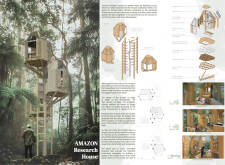5 key facts about this project
### Overview
The Amazon Research House is strategically located in the heart of the Amazon rainforest, designed as a multifunctional space to support researchers dedicated to the study and preservation of the region's unique ecological system. This initiative confronts critical environmental challenges, including conservation and the socio-political issues surrounding deforestation in Brazil. The structure emphasizes a balance between human activity and the natural landscape, aiming to minimize ecological disruption while maximizing research efficiency.
### Architectural Strategy
Characterized by a triangular form, the design integrates into the dense forest, reducing visual impact and land disturbance. Elevating the structure protects it from flooding and wildlife interactions while maintaining a minimal environmental footprint. The layout consists of three modular units, delineating areas for sleeping, cooking, and research. This organization promotes efficient use of space while maximizing functionality. The vertical orientation of the building reflects the growth patterns of Amazonian trees, encouraging a novel approach to living spaces that embraces verticality over traditional horizontal designs.
### Material and Sustainability
The Amazon Research House utilizes sustainable materials to support its eco-conscious intent. Cross Laminated Timber (CLT) is essential for achieving structural stability while allowing open interiors. A wooden roof provides insulation and complements the natural surroundings. Glass walls and roofs facilitate natural light and expansive views of the forest, enhancing the occupants' connection to their environment. The inclusion of solar panels promotes renewable energy use, and a rainwater collection system addresses water accessibility challenges in remote areas, underscoring the project’s commitment to sustainability and environmental compatibility.
The house's dedicated research laboratory incorporates elements suited for ecological studies, reinforcing its role as a site for scientific inquiry. By elevating the structure, the design preserves local vegetation and mitigates ecosystem disruption, while its communal layout fosters collaboration among researchers, enhancing collective efforts in their conservation mission.



















































